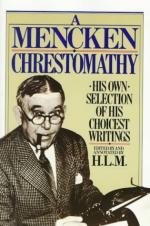|
This section contains 529 words (approx. 2 pages at 400 words per page) |

|
A Mencken Chrestomathy Summary & Study Guide Description
A Mencken Chrestomathy Summary & Study Guide includes comprehensive information and analysis to help you understand the book. This study guide contains the following sections:
This detailed literature summary also contains Topics for Discussion on A Mencken Chrestomathy by H. L. Mencken.
A Mencken Chrestomathy is a compilation of the writings of Henry Louis Mencken, from his own selection of his best work. H. L. Mencken (1880-1956) grew up, lived and died in Baltimore, Maryland. His parents were August and Anna Mencken and he grew up with a private education, afterward attending Baltimore Polytechnic. Mencken married in 1930, his wife, Sara Powell Haardt, died in 1935.
Mencken started a job as a reported for the Baltimore Morning Herald in 1899 and quickly rose to become city editor in 1903; by 1905, he had shot up to city editor for the Evening Herald. Between 1906 and 1910, he worked for the Baltimore Sun and from 1910 to 1917 for the Evening Sun. After a three year hiatus, Mencken returned to his job at the Evening Sun in 1920 and would work there until 1935. Mencken never stopped associating with the Sun papers and helped direct their publishing company, the A. S. Abell Co. In 1908, Mencken began to edit the Smart Set and shared the editorship between 1914 and 1923. He and his co-editor, George Jean Nathan, created The American Mercury in 1924, and Mencken was its editor for the next nine years.
During his thirty-four years in journalism and editing, H. L. Mencken became one of the nation's most famous popular writers in part because of his acerbic wit, excellent writing, clever aphorisms and his ability to skewer great men with ease. That his fame was justified will become immediately apparent to any reader of A Mencken Chrestomathy. The book is a cross-section of Mencken's writings on many topics, all of which, in Mencken's words, contains a bit of "ribaldry" because they are often comic, even when the issue is serious. Mencken refuses to apologize for this.
The book has thirty chapters and each of the chapters contain essays; some chapters are short, containing two to four essays, others are much longer, with twenty or more pieces drawn together. The chapters range over particular subject matters, and they appear to be arranged in some reasonable order.
Chapter 1, Homo Sapiens, contains Mencken's thoughts on human nature and Chapter 2 outlines Mencken's analysis of types of men. In Chapter 3, Mencken turns to his thoughts on women, and Chapter 4 has Mencken discuss religion. Chapters 5 and 6 cover morals and crime and punishment respectively, while Chapter 7 touches on death. In Chapter 8, Mencken skewers government and its nature, whereas in Chapter 9, he does the same to democracy. Chapter 10 cuts loose in attacks on the American people and Chapter 11 focuses on doutherners, among Mencken's favorite whipping boys.
Chapter 12 covers history, 13, American statesmen, 14, other American "Immortals", and 15 tells the story of various unusual but often unknown men. The next five chapters cover fields of study, including economics, teaching, psychology and science generally; these are followed with a chapter on "quackery". Chapter 21 takes the reader through Mencken's reflections on the human body, and Chapter 22 covers pieces of 'utopian flights'.
Chapter 23 contains some of Mencken's best works of journalism, such as his coverage of the Scopes Monkey Trial, whereas Chapter 24, 25 and 26 review literary criticism, literature and the literati. Chapter 27 discusses music, Chapter 28 the 'lesser' arts. Chapter 29 contains Mencken's silliest essays and Chapter 30 contains his various apothegms and aphorisms. Chapter 31 is a brief appendix.
Read more from the Study Guide
|
This section contains 529 words (approx. 2 pages at 400 words per page) |

|



